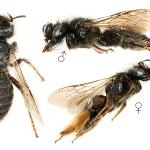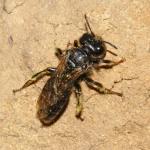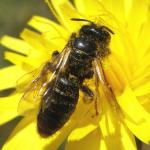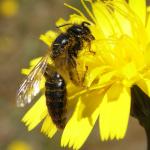A medium-sized, all black, scantily-haired bee with dirty-yellow scopae on the hind legs of the female. In dull weather males are often found curled up in the flowers of yellow- flowered Asteraceae, especially hawkweeds.They may stay shut inside the closed flower overnight.
Known from England, as far north as South Yorkshire, and Wales. It is also present in the Channel Islands.
Overseas: Europe, from Finland south to Spain, and East to Turkey and the Urals.
This species is not regarded as being of conservation concern and is not listed in Shirt (1987) or Falk (1991)
Associated with short- to medium-height grasslands over sandy or sandy-clay soils. It is often particularly frequent on coastal grasslands.
Univoltine, June to August.
Nests singly in the ground in open situations, although there are reports of females sharing burrows (G R Else in prep.), particularly where there is hard-packed, bare ground, such as along footpaths. Unusually, the nest entrances do not have mounds of excavated soil around them.
Yellow-flowered Asteraceae.
Nomada similis Morawitz is a cleptoparasite of this species in the Channel Islands. However, this Nomada is currently unknown from elsewhere in the region covered by this atlas. Nomada fabriciana (L.) has been recorded as a cleptoparasite in early literature (e.g. Shuckard 1866, Smith 1876), but this has not been confirmed by modern observations and seems very unlikely.
Updated 12/10/2012





